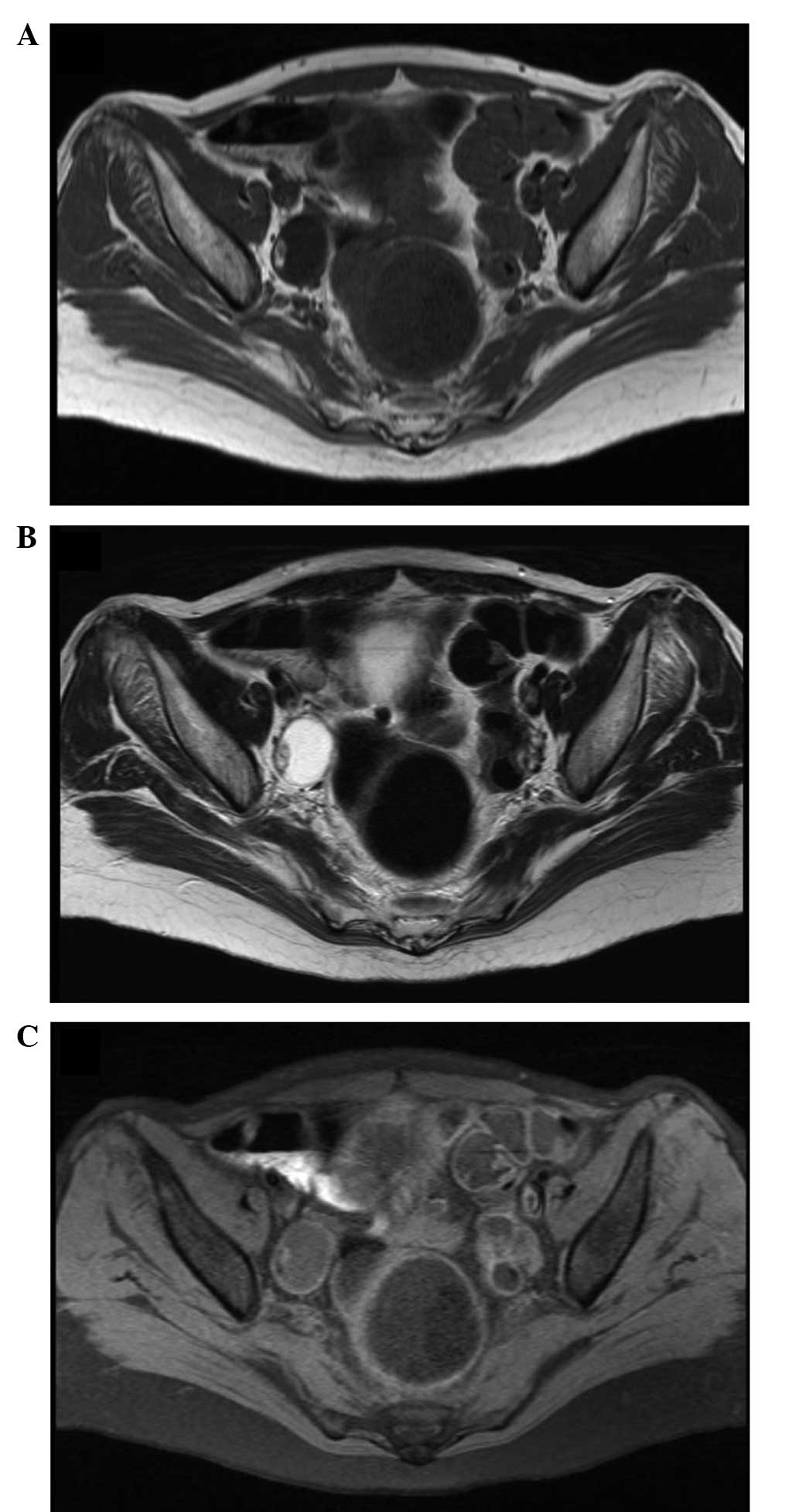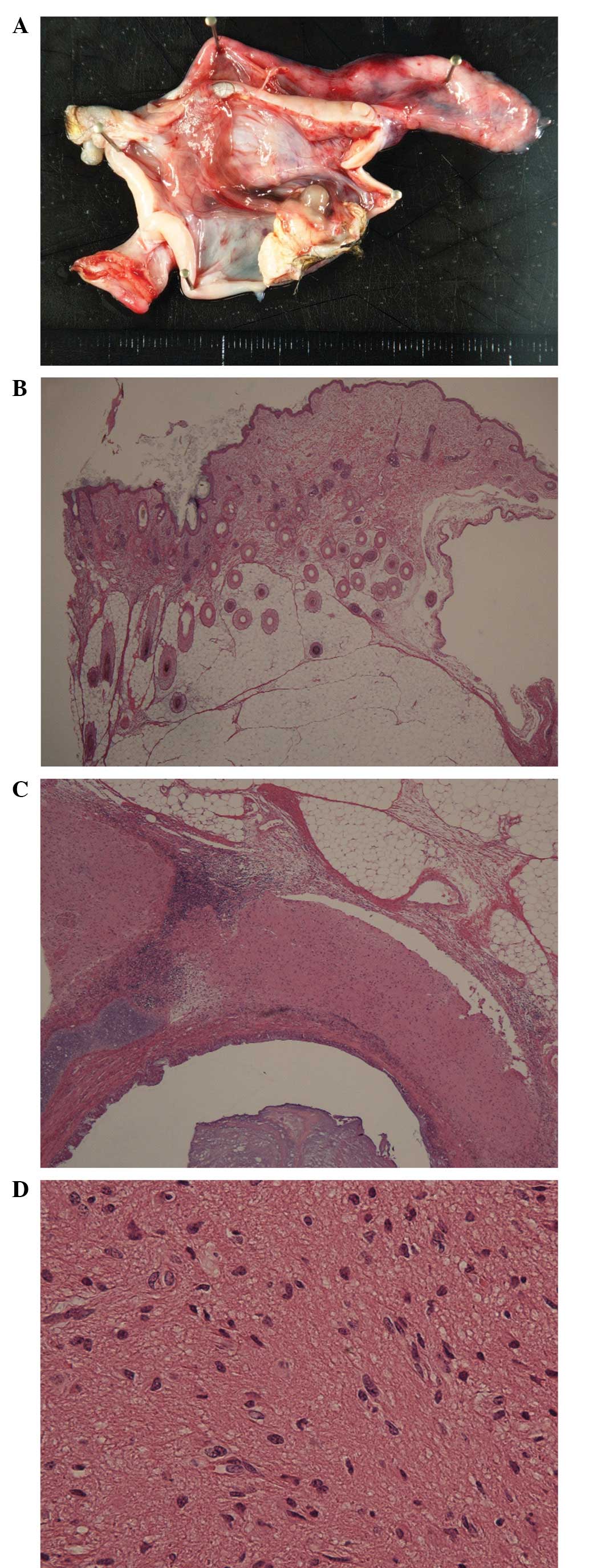Complete recovery from paraneoplastic anti-NMDAR encephalitis associated with a small ovarian teratoma following a laparoscopic salpingo-oophorectomy: A case report
- Authors:
- Kenji Imai
- Takeshi Fukuda
- Takuma Wada
- Masaru Kawanishi
- Makoto Yamauchi
- Yasunori Hashiguchi
- Tomoyuki Ichimura
- Tomoyo Yasui
- Toshiyuki Sumi
-
View Affiliations
Affiliations: Department of Obstetrics and Gynecology, Graduate School of Medicine, Osaka City University, Osaka 545‑8585, Japan
- Published online on: March 11, 2015 https://doi.org/10.3892/etm.2015.2344
-
Pages:
1723-1726
Metrics:
Total
Views: 0 (Spandidos Publications: | PMC Statistics:
)
Metrics:
Total PDF Downloads: 0 (Spandidos Publications: | PMC Statistics:
)
This article is mentioned in:
Abstract
Anti-N-methyl-D-aspartate receptor (anti-NMDAR) encephalitis is a severe but treatment‑responsive disorder, initially identified in young women with an ovarian teratoma. Symptoms include mood, behavior and personality irregularities that resemble acute psychosis. The present study reports the rare case of a patient with anti‑NMDAR encephalitis and severe neurological symptoms, that exhibited a rapid recovery following a laparoscopic salpingo‑oophorectomy. The 39‑year‑old woman was admitted to the Department of Obstetrics and Gynecology, Osaka City University Graduate School of Medicine (Osaka, Japan) with a 5‑day history of fever and stomach ache. One week later, the patient developed hallucinations and emotional lability. Initially, a diagnosis of limbic or herpes encephalitis was considered; thus, the patient was administered acyclovir and received steroid pulse therapy. However, the patient subsequently developed apnea, and in response, a tracheal intubation, mechanical ventilation and plasmapheresis were performed. Anti‑NMDAR encephalitis was subsequently considered as a diagnosis and mediastinal and pelvic computed tomography (CT) examinations were conducted to detect for the presence of a teratoma. A 24x24‑mm cystic lesion was identified in the pelvis from an abdominal CT scan and the lesion appeared to be an ovarian teratoma. In addition, serum and cerebrospinal fluid samples were collected, and were found to test positive for anti‑NMDAR antibodies. A laparoscopic salpingo‑oophorectomy was performed, which resulted in rapid improvement of the patient's mental symptoms, followed by a complete recovery.
View References
|
1
|
Nokura K, Yamamoto H, Okawara Y, Koga H,
Osawa H and Sakai K: Reversible limbic encephalitis caused by
ovarian teratoma. Acta Neurol Scand. 95:367–373. 1997. View Article : Google Scholar : PubMed/NCBI
|
|
2
|
Okamura H, Oomori N and Uchitomi Y: An
acutely confused 15-year-old girl. Lancet. 350:4881997. View Article : Google Scholar : PubMed/NCBI
|
|
3
|
Dalmau J, Tüzün E, Wu HY, Masjuan J, Rossi
JE, Voloschin A, Baehring JM, Shimazaki H, Koide R, King D, et al:
Paraneoplastic anti-N-methyl-d-aspartate receptor encephalitis
associated with ovarian teratoma. Ann Neurol. 61:25–36. 2007.
View Article : Google Scholar : PubMed/NCBI
|
|
4
|
Lynch DR, Anegawa NJ, Verdoorn T and
Pritchett DB: N-methyl-D-aspartate receptors: different subunit
requirements for binding of glutamate antagonists, glycine
antagonists and channel-blocking agents. Mol Pharmacol. 45:540–545.
1994.PubMed/NCBI
|
|
5
|
Dalmau J, Gleichman AJ, Hughes EG, Rossi
JE, Peng X, Lai M, Dessain SK, Rosenfeld MR, Balice-Gordon R and
Lynch DR: Anti-NMDA-receptor encephalitis: Cases series and
analysis of the effect of antibodies. Lancet Neurol. 7:1091–1098.
2008. View Article : Google Scholar : PubMed/NCBI
|
|
6
|
Iizuka T, Sakai F, Ide T, Monzen T, Yoshii
S, Iigaya M, Suzuki K, Lynch DR, Suzuki N, Hata T and Dalmau J:
Anti-NMDA receptor encephalitis in Japan: Long-term outcome without
tumor removal. Neurology. 70:504–511. 2008. View Article : Google Scholar : PubMed/NCBI
|
|
7
|
Florance NR, Davis RL, Lam C, Szperka C,
Zhou L, Ahmad S, Campen CJ, Moss H, Peter N, Gleichman AJ, et al:
Anti-N-methyl-D-aspartate receptor (NMDAR) encephalitis in children
and adolescents. Ann Neurol. 66:11–18. 2009. View Article : Google Scholar : PubMed/NCBI
|
|
8
|
Ishiura H, Matsuda S, Higashihara M,
Hasegawa M, Hida A, Hanajima R, Yamamoto T, Shimizu J, Dalmau J and
Tsuji S: Response of anti-NMDA receptor encephalitis without tumor
to immunotherapy including rituximab. Neurology. 71:1921–1923.
2008. View Article : Google Scholar : PubMed/NCBI
|
|
9
|
Sansing LH, Tüzün E, Ko MW, Baccon J,
Lynch DR and Dalmau J: A patient with encephalitis associated with
NMDA receptor antibodies. Nat Clin Pract Neurol. 3:291–296. 2007.
View Article : Google Scholar : PubMed/NCBI
|
|
10
|
Seki M, Suzuki S, Iizuka T, Shimizu T,
Nihei Y, Suzuki N and Dalmau J: Neurological response to early
removal of ovarian teratoma in anti-NMDAR encephalitis. J Neurol
Neurosurg Psychiatry. 79:324–326. 2008. View Article : Google Scholar : PubMed/NCBI
|













